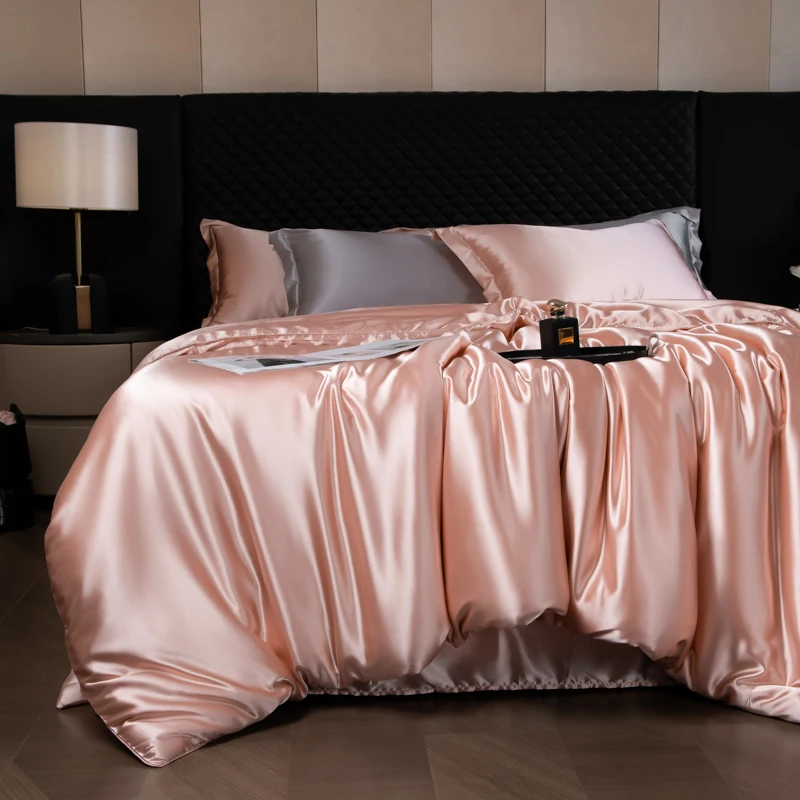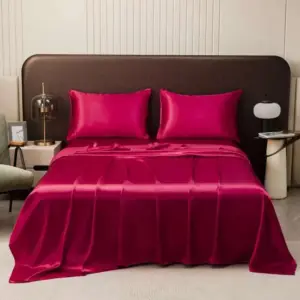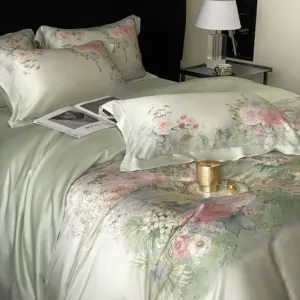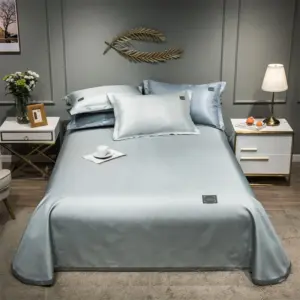Introduction to Natural Fabrics: Silk and Cotton
When it comes to the fabrics that touch our skin every day, the choice between silk and cotton can significantly impact our comfort, health, and even our appearance. These two natural fibers stand at opposite ends of the textile spectrum, each with its own distinct characteristics and benefits.
Silk is a natural protein fiber produced by silkworms during their cocoon-building process. This luxurious material has been treasured for thousands of years, beginning in ancient China where it was so valuable that it was reserved exclusively for royalty. The exceptional qualities of what makes mulberry silk special have established it as a premium fabric often called the “Queen of Fabrics” for its unmatched smoothness and lustrous appearance.
Cotton, on the other hand, is a natural plant-based fiber harvested from the seedpods of cotton plants. This versatile material has been cultivated worldwide for centuries and has earned its reputation as the “King of Fabrics” due to its widespread use, durability, and accessibility.
The differences between these two natural powerhouses extend far beyond their origins. Throughout this guide, we’ll explore how silk and cotton compare across essential attributes like texture, temperature regulation, moisture management, skin benefits, durability, and more—all to help you make informed decisions about which fabric best serves your specific needs.
Quick Comparison: Silk vs. Cotton at a Glance
Before diving into the detailed differences between silk and cotton, this quick reference table provides a comprehensive overview of how these two natural fabrics compare across key attributes. Use this as your starting point or refer back to it as you explore specific aspects in more depth.
| Attribute | Silk | Cotton |
|---|---|---|
| Source | Animal fiber (silkworm cocoons) | Plant fiber (cotton plant seedpods) |
| Fiber Type | Protein-based (fibroin) | Cellulose-based |
| Texture/Feel | Smooth, lustrous, slippery | Soft, textured, crisp |
| Luster/Appearance | High sheen, reflective | Mostly matte, natural look |
| Breathability | Good | Excellent |
| Moisture Management | Moisture-wicking (repels moisture) | Highly absorbent (soaks up moisture) |
| Hypoallergenic | Excellent (naturally resistant to dust mites) | Good (when washed frequently) |
| Temperature Regulation | Excellent (cooling in summer, insulating in winter) | Good (excellent for hot weather) |
| Durability | Strong but delicate (requires careful handling) | Very durable with proper care |
| Care Requirements | Hand wash or delicate cycle, air dry | Machine washable, tumble dry |
| Typical Cost (Queen Sheet Set) | $80-500+ | $20-100+ |
| Environmental Impact | Biodegradable, lower water usage | Biodegradable, higher water usage |
As you can see from this overview, both mulberry silk bed sheets and cotton offer distinct advantages depending on your specific needs. Let’s explore each of these characteristics in more detail to help you determine which fabric might be right for your specific situation.
The Origin Story: How Silk and Cotton Are Made
Understanding how these fabrics are created helps explain their unique properties and why they behave so differently in various applications.
Silk Production Process
Silk production, known as sericulture, is a fascinating process that begins with the humble silkworm (Bombyx mori). These caterpillars feed exclusively on mulberry leaves before spinning their cocoons using twin glands that produce a protein called fibroin. This protein is coated with sericin, a gum-like substance that helps form the cocoon structure.
The traditional harvesting process involves carefully heating the cocoons to kill the pupae before they emerge as moths (which would otherwise break the continuous silk filament). Each cocoon can yield between 300-900 meters of continuous silk filament. These filaments are then unwound and several are twisted together to create silk thread strong enough for weaving or knitting.
Mulberry silk is the highest quality and most desirable type of silk, representing over 90% of silk produced worldwide. The distinctive qualities of mulberry silk sheets come from their fine, uniform filaments and high protein content. The quality of silk is often measured in momme weight (similar to thread count), with premium silk typically falling in the 19-25 momme range, striking the ideal balance between luxurious feel and durability.
Cotton Production Process
Cotton production begins with the cultivation of cotton plants, which produce fluffy bolls containing seeds surrounded by soft fibers. Once harvested, these bolls undergo ginning—a process that separates the seeds from the fibers. The resulting cotton fibers, which are almost pure cellulose, are then cleaned, carded (aligned), and spun into yarn.
Different varieties of cotton produce different qualities of fiber. Upland cotton represents about 90% of world production and is characterized by shorter fibers (staple length). Premium varieties like Egyptian cotton or Pima cotton feature extra-long staples, resulting in stronger, softer fabrics that resist pilling and maintain their integrity longer.
The natural cellulose structure of cotton fibers gives this material its characteristic properties—high absorbency, strength when wet, and excellent breathability. These qualities make cotton particularly suitable for everyday items that require frequent washing and durability.
Texture and Feel: The Sensory Experience
The tactile experience of fabric against our skin greatly impacts our comfort and preference, making texture one of the most noticeable differences between silk and cotton.
Silk Texture and Feel
Silk offers an unparalleled smooth, cool-to-the-touch surface that glides effortlessly across the skin. This distinctive feel comes from the triangular prism-like structure of silk fibers that reflects light at different angles, creating both its smoothness and characteristic luster.
The fabric has a fluid drape that gracefully follows body contours, feeling almost weightless despite its strength. When you run your fingers across silk, there’s almost no resistance—just a cool, slippery sensation that many describe as “liquid fabric.”
The weave and silk momme weight significantly impact how silk feels. Charmeuse silk, with its satin weave, presents a glossy front side and matte reverse, while habotai (China silk) offers a more uniform feel. Higher momme weights (19-25) provide a more substantial hand-feel while maintaining silk’s characteristic drape, making them ideal for bedding applications.
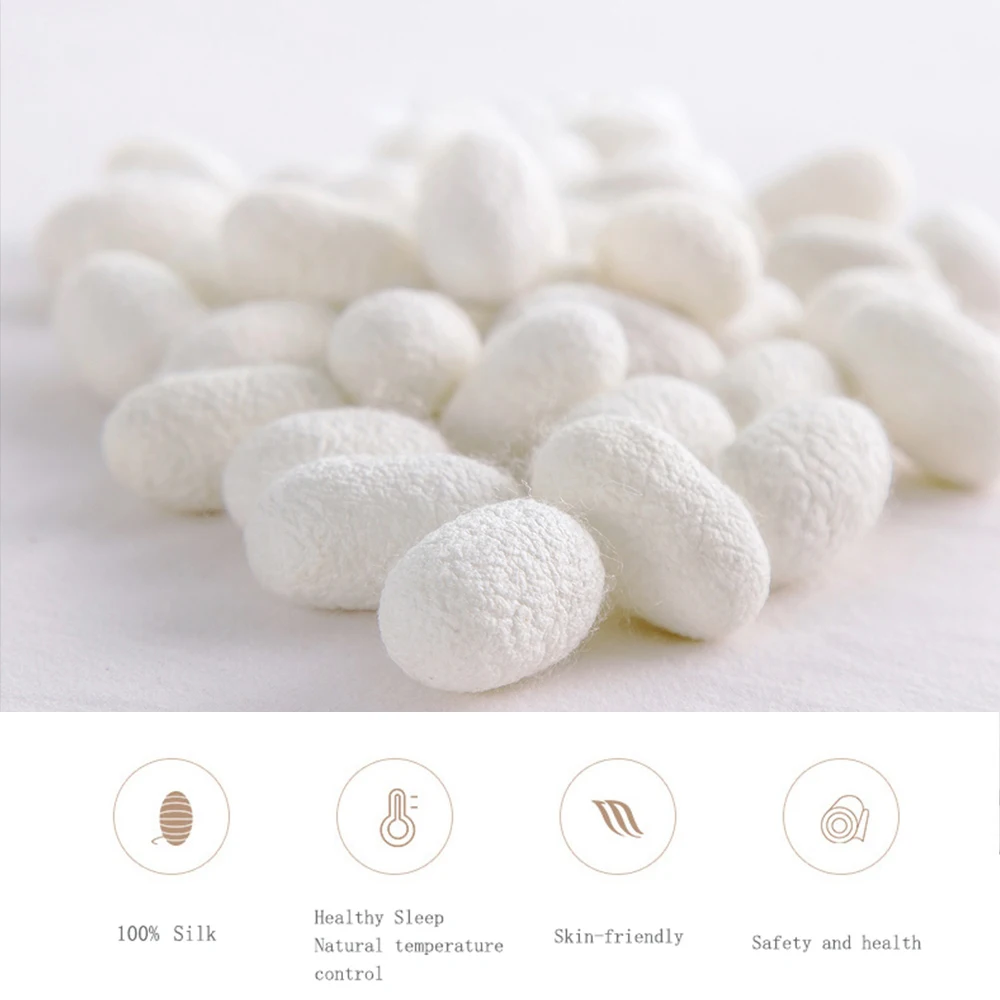
Cotton Texture and Feel
Cotton presents a distinctly different sensory experience. It offers a soft but more textured surface that provides gentle friction against the skin. This natural grip makes cotton easy to handle and less slippery than silk.
High-quality cotton, particularly when new, has a crisp feel that many people associate with freshness. Over time and with washing, cotton typically becomes softer while maintaining its structural integrity. The substantial weight and stable drape of cotton fabrics create a sense of security and comfort that many find reassuring.
Different cotton varieties offer varying textures—Egyptian and Pima cottons are renowned for their exceptional softness due to their longer fibers. Thread count also impacts the feel, with higher thread counts (400-800) generally providing a smoother, denser fabric, though extremely high thread counts don’t necessarily translate to better quality.
Temperature Regulation and Breathability
How a fabric interacts with body temperature can make the difference between comfortable rest and a night of tossing and turning due to overheating or chills.
Silk’s Temperature Regulation
Silk possesses remarkable natural thermoregulating properties that few other fabrics can match. The protein structure of silk fibers creates a naturally adaptive material that helps transform sleep quality by maintaining comfort in both warm and cool conditions.
In warm weather, silk feels cool against the skin because it efficiently wicks moisture away from the body rather than absorbing it. This evaporative effect helps maintain a comfortable sleeping temperature. Simultaneously, silk’s low conductivity means it doesn’t readily draw heat away from the body in colder conditions.
This unique combination makes temperature regulation with silk sheets particularly effective. Scientific studies have shown that silk can help maintain body temperature within the ideal range for comfortable sleep, typically keeping sleepers 1-2°F cooler in hot conditions and warmer in cold conditions compared to many other fabrics.
Cotton’s Temperature Regulation
Cotton excels at breathability, which is why it’s often the go-to fabric for hot weather. The natural cellulose fibers create a porous weave that allows exceptional air circulation, helping heat to dissipate from the body.
Where cotton particularly shines is in its ability to absorb moisture without immediately feeling damp. This high absorbency helps draw perspiration away from the skin, creating a cooling effect as the moisture evaporates. However, once saturated, cotton can retain moisture longer than silk, potentially leading to discomfort in very humid conditions or for heavy night sweaters.
Different cotton weaves significantly impact its temperature performance. Percale offers a crisp, cool feel ideal for hot sleepers, while sateen provides slightly better insulation for year-round use. For those who struggle with overheating during sleep, cooling silk sheets often provide a more consistent temperature experience throughout the night.
Moisture Management: Wicking vs. Absorption
How fabrics handle moisture significantly impacts comfort, especially during sleep when the body naturally releases moisture.
Silk’s Moisture Handling
Silk has a counter-intuitive relationship with moisture. Despite having low absorbency compared to cotton, silk excels at moisture management through efficient wicking. The protein structure of silk allows it to repel water molecules while still transporting them away from the body.
One of silk’s most remarkable properties is its ability to absorb up to 30% of its weight in moisture without feeling wet to the touch. This means that even when silk is handling significant moisture during sleep, it maintains its dry, comfortable feel against the skin.
Silk also dries much faster than cotton once wet, preventing that clammy sensation that can disrupt sleep. The protein structure maintains a moisture barrier similar to what’s found in healthy skin and hair, helping the body retain its natural hydration while still managing excess moisture effectively.
Cotton’s Moisture Handling
Cotton’s approach to moisture is fundamentally different—it’s highly absorbent, capable of holding up to 25 times its weight in water. This impressive capacity means cotton quickly draws moisture away from the skin, which can feel immediately cooling and comfortable.
However, cotton’s high absorbency comes with tradeoffs. Once saturated, cotton can feel noticeably damp against the skin and takes significantly longer to dry than silk. In humid environments or for those who perspire heavily during sleep, cotton sheets may remain damp for extended periods, potentially creating discomfort.
Cotton’s absorption properties make it excellent for certain applications like bath towels, where maximum water uptake is desirable. For bedding, this characteristic is beneficial for those who don’t sweat excessively but can become problematic for hot sleepers or in humid climates.
Benefits for Skin and Hair
Beyond comfort, the fabrics we sleep on can significantly impact the health and appearance of our skin and hair.
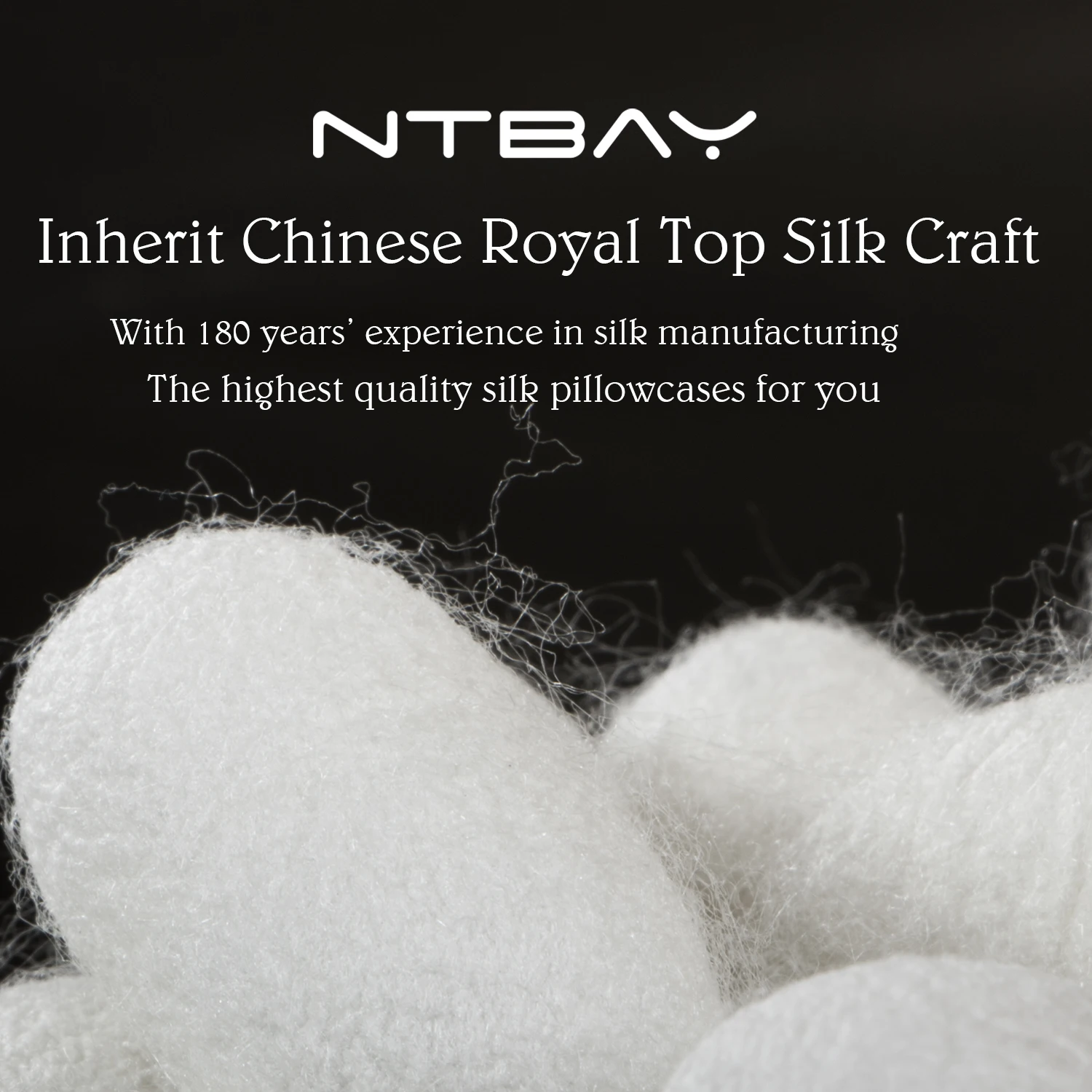
Silk Benefits for Skin and Hair
Silk offers numerous advantages for skin and hair health, which is why dermatologists often recommend it, particularly for those with sensitive skin concerns:
- Dramatically reduced friction against skin and hair, helping prevent sleep wrinkles, bed head, and hair breakage
- Amino acid composition remarkably similar to human skin proteins, making it compatible with even sensitive complexions
- Preservation of natural skin moisture and hair oils that cotton might absorb away
- Natural hypoallergenic properties beneficial for those with eczema, rosacea, or acne-prone skin
- Anti-aging benefits through prevention of sleep creases and preservation of skincare products applied before bed
The skin benefits of mulberry silk bedding are particularly notable for those concerned with aging. The smooth surface creates less compression on facial skin, potentially reducing the formation of sleep wrinkles over time. Similarly, silk pillowcases benefit hair by reducing friction that causes frizz, tangles, and breakage—especially important for those with curly, fragile, or color-treated hair.
For those looking to experience these benefits, silk pillowcases are often the gateway product, offering significant improvements with relatively minimal investment.
Cotton Effects on Skin and Hair
Cotton’s interaction with skin and hair is quite different due to its textured surface and high absorbency:
- Higher friction against skin and hair can contribute to sleep creases and morning bed head
- Significant absorption of natural oils and moisture from skin and hair, potentially leading to dryness
- Beneficial absorption properties for very oily skin types who want to reduce excess sebum
- Potential for skin irritation from rougher texture, particularly for those with sensitive skin conditions
- Varying impacts based on cotton type—organic, combed cotton is generally gentler on sensitive skin
For those without specific skin or hair concerns, cotton’s familiar feel and easy care make it a practical choice. However, for individuals dealing with sensitive skin, aging concerns, or fragile hair, the advantages of silk sheets for sensitive skin may outweigh cotton’s conveniences.
Hypoallergenic Properties and Allergies
For allergy sufferers, the choice between silk and cotton can significantly impact sleep quality and overall health.
Silk’s Hypoallergenic Profile
Silk stands out for its exceptional natural resistance to common allergens. The tight weave and smooth fibers of silk create an inhospitable environment for dust mites, which are a primary trigger for many allergy and asthma sufferers.
The protein structure of silk naturally repels potential irritants rather than trapping them. Studies have found that silk accumulates significantly fewer allergens compared to other common bedding materials, making it an excellent choice for those with respiratory sensitivities.
Additionally, silk requires minimal chemical processing compared to many other fabrics, reducing potential irritants for those with chemical sensitivities. The natural antimicrobial properties of silk also help prevent the buildup of bacteria and fungi that could trigger allergic responses.
These hypoallergenic properties of silk fabric make it particularly valuable for those suffering from allergic rhinitis, asthma, or skin conditions like eczema. Many users report reduced symptoms and improved sleep quality after switching to silk bedding.
Cotton’s Allergy Considerations
Cotton also offers several hypoallergenic benefits, particularly when compared to synthetic fabrics. As a natural fiber, cotton is less likely to cause skin reactions than petroleum-based synthetic materials.
However, cotton’s absorbent and textured nature can potentially harbor dust mites and other allergens if not washed frequently. This is particularly true for cotton bedding, which should be washed in hot water weekly to maintain its hypoallergenic properties.
Organic cotton presents additional benefits for those with chemical sensitivities, as it avoids the pesticides and processing chemicals used in conventional cotton production. For allergy sufferers who prefer cotton’s feel, organic options washed frequently in hot water can provide good allergen control.
Cotton’s excellent washability is an advantage for allergy management—it can withstand the hot water temperatures needed to kill dust mites and remove allergens effectively, unlike some delicate fabrics that require special care.
Durability and Longevity
The lifespan of fabric products significantly impacts their overall value, making durability an important consideration when comparing silk and cotton.
Silk’s Strength and Durability
Silk possesses surprising strength despite its delicate appearance. Pound for pound, silk fiber is stronger than steel of the same diameter, a remarkable natural engineering feat. This inherent strength gives silk bedding and garments significant potential longevity.
However, silk’s durability comes with specific vulnerabilities. Prolonged exposure to sunlight can weaken silk fibers, as can harsh detergents containing enzymes or bleach. With proper care, quality silk bedding (especially in the optimal 19-25 momme weight range) can last 3-5+ years while maintaining its distinctive properties.
This longevity makes luxury silk bedding sets a worthwhile investment over time. While the initial purchase price is higher, the cost per use often becomes comparable to less expensive fabrics when considering the extended lifespan and retained quality.
Silk’s durability varies significantly with quality—higher momme weights and mulberry silk typically offer the best combination of strength and luxurious feel, resulting in products that maintain their integrity through years of proper use.
Cotton’s Strength and Durability
Cotton has earned its reputation for durability through centuries of everyday use. Cotton fibers form strong hydrogen bonds, creating fabrics that withstand regular washing, daily use, and constant handling.
Cotton’s excellent resistance to abrasion means it doesn’t easily develop worn spots or pilling with normal use. High-quality cotton bedding typically lasts 2-3+ years before showing significant signs of wear, though this varies with thread count and cotton type.
Thread count significantly impacts cotton’s durability—higher thread counts (400-600) generally indicate stronger fabric, though extremely high counts can sometimes use weaker, shorter fibers. Long-staple cotton varieties like Egyptian or Pima offer superior durability due to their longer fibers that resist pilling and breaking.
While cotton generally maintains its structural integrity well, it may show visible signs of aging sooner than silk. Cotton can gradually thin, fade, or lose its crisp appearance over time, especially with frequent washing and drying at high temperatures.
Care and Maintenance Requirements
The effort required to maintain fabric quality directly impacts both user experience and the material’s lifespan.
Caring for Silk
Silk’s reputation for delicate care requirements is partially deserved but often exaggerated. With the right approach, maintaining silk doesn’t have to be overly burdensome:
- Washing: Gentle hand washing in lukewarm water (30°C/86°F) is ideal, though many modern silk items can be machine washed on a delicate/silk cycle in mesh laundry bags
- Detergent: Use pH-neutral cleaners specifically formulated for silk or gentle shampoo; avoid enzymes, bleach, and fabric softeners
- Drying: Never wring silk; instead, roll in a towel to remove excess moisture, then air dry away from direct sunlight
- Ironing: If needed, iron on the lowest setting while the silk is slightly damp, using a pressing cloth between the iron and fabric
- Storage: Store clean, dry silk items away from direct sunlight in breathable fabric bags rather than plastic
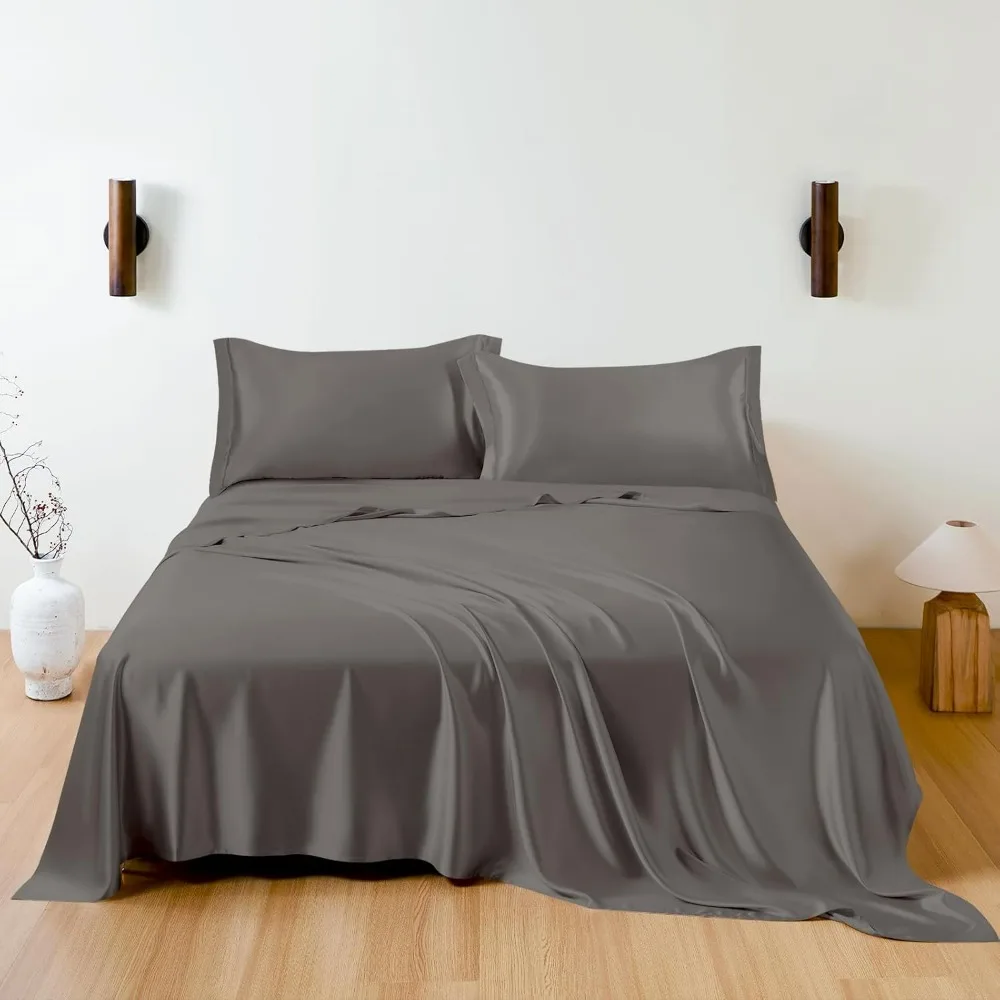
Common mistakes to avoid include using hot water, bleach-based cleaners, or wringing out wet silk—all of which can damage the protein fibers. For those seeking easier care options, washable silk sheets are specially treated to withstand machine washing with less risk of damage.
Caring for Cotton
Cotton’s straightforward care is one of its greatest advantages:
- Washing: Machine washable in warm or hot water, depending on the fabric weight and color
- Detergent: Compatible with most laundry detergents, though harsh chemicals may shorten lifespan
- Drying: Can be tumble dried on medium or high heat for most items, though line drying preserves fiber integrity
- Ironing: Easily ironed on medium to high heat settings, particularly when slightly damp
- Storage: Can be folded and stored in any clean, dry location without special considerations
To maintain cotton’s softness and prevent pilling, consider washing items inside out, using appropriate water temperatures for colors versus whites, and avoiding overloading the washing machine to ensure proper rinsing.
Cotton’s resilience to various washing methods makes it particularly convenient for everyday items that require frequent laundering, though premium cotton items benefit from gentler treatment for maximum longevity.
Cost and Value Considerations
Understanding the true value proposition of silk versus cotton requires looking beyond initial price tags to consider longevity, benefits, and cost per use.
Silk Pricing Factors
Silk’s higher price point stems from its labor-intensive production process and relative scarcity. A single pound of raw silk requires approximately 2,500 silkworms consuming 25 pounds of mulberry leaves. This resource-intensive process, combined with the skilled labor required to harvest and process the delicate filaments, naturally results in a premium material.
Quality silk bedding typically ranges from:
* Pillowcases: $30-150 per standard case
* Sheet sets (Queen): $250-800
* Comforters/Duvets: $150-1,000+
Several factors influence silk pricing, including momme weight (higher generally means more costly), silk type (mulberry being premium), production methods (handcrafted commanding higher prices), and whether the silk is organic or conventionally produced.
The value proposition of silk lies in its longevity when properly cared for, its unique benefits for skin and hair, and its unmatched comfort. Mulberry silk sheets often demonstrate better value over time—a $400 set lasting 5 years costs about $0.22 per night, comparable to less expensive fabrics requiring more frequent replacement.
Cotton Pricing Factors
Cotton offers a wide price range reflecting its variety of qualities and production methods:
* Pillowcases: $5-60 per standard case
* Sheet sets (Queen): $20-300
* Comforters/Duvets: $30-400+
The substantial price variation in cotton products reflects differences in cotton type (Egyptian and Pima commanding premium prices), thread count (higher generally costing more), weave construction, and organic certification (organic cotton typically costs 20-50% more than conventional).
Basic cotton bedding presents excellent initial value but may require more frequent replacement. Premium cotton varieties offer better longevity—a $150 Egyptian cotton sheet set lasting 3 years costs about $0.14 per night, representing good value for everyday use.
Cotton’s value advantage diminishes somewhat when considering the potential additional benefits of silk for skin, hair, and allergy sufferers, which may offset the higher initial investment for those with specific concerns.
Environmental Impact and Sustainability
As environmental consciousness grows, the ecological footprint of our textile choices becomes increasingly important.
Silk’s Environmental Profile
Silk production offers several environmental advantages. The material is completely biodegradable, returning to the earth within 1-5 years when discarded, compared to centuries for synthetic alternatives.
Water usage in silk production is relatively moderate—significantly less than conventional cotton. Mulberry trees require minimal irrigation in most regions, and the processing of silk typically uses less water than many other textile productions.
Traditional silk farming creates a balanced agricultural system—mulberry trees prevent soil erosion while providing food for silkworms. However, conventional silk production does raise ethical questions regarding the silkworms, which are killed during the harvesting process.
In response to these concerns, several alternatives have emerged, including peace silk (allowing moths to emerge before harvesting) and various eco-friendly silk bedding options that employ more sustainable production methods while maintaining quality.
Cotton’s Environmental Profile
Cotton’s environmental impact largely depends on how it’s grown and processed. Conventional cotton cultivation is among the most pesticide-intensive agricultural practices, accounting for approximately 16% of global insecticide usage despite occupying just 2.5% of agricultural land.
Water consumption represents cotton’s most significant environmental challenge—producing 1 pound of cotton can require up to 1,800 gallons of water. This intensive water requirement has contributed to environmental disasters like the shrinking of the Aral Sea where extensive cotton irrigation diverted essential water sources.
Organic cotton offers a more sustainable alternative, eliminating synthetic pesticides and fertilizers while typically using 88% less water and 62% less energy than conventional cotton. Many conscientious consumers now seek out organic cotton certifications as a more environmentally responsible choice.
Both fabrics are biodegradable natural fibers, making them more environmentally friendly than synthetic alternatives that may persist in landfills for hundreds of years.
Pros and Cons Summary: Silk
To help crystallize your understanding of silk’s attributes, here’s a concise summary of its main advantages and limitations.
Pros of Silk
- Exceptionally smooth texture that glides across skin and hair without causing friction
- Natural temperature-regulating properties that adapt to both warm and cool conditions
- Hypoallergenic nature that resists dust mites, mold, and common allergens
- Excellent moisture-wicking ability while maintaining natural hydration
- Significant benefits for skin and hair health, potentially reducing wrinkles and breakage
- Long-lasting when properly maintained, often lasting 3-5+ years
- Luxurious appearance with natural sheen and elegant drape
The advantages of sleeping on mulberry silk extend beyond mere luxury—many users report tangible improvements in sleep quality, skin appearance, and hair manageability after making the switch.
Cons of Silk
- Higher initial cost compared to most other natural fabrics
- Requires more attentive care to maintain quality and appearance
- Can feel slippery or unstable for some sleepers unused to its smooth surface
- Vulnerable to damage from harsh chemicals, high heat, and direct sunlight
- Special washing considerations that may be inconvenient for some users
- More likely to show water stains if not properly dried after cleaning
- Limited color options due to dyeing challenges with natural silk fibers
Pros and Cons Summary: Cotton
Cotton offers its own distinct set of advantages and limitations that make it suitable for different needs and preferences.
Pros of Cotton
- Affordability and accessibility across a wide range of budgets
- Simple care requirements with excellent machine washability
- Superior breathability making it ideal for hot sleepers and warm climates
- Remarkable durability that withstands frequent washing and regular use
- Extensive variety in types, weaves, and price points to suit different needs
- Familiar, comfortable feel that many people associate with freshness
- Natural, biodegradable composition without synthetic components
Cons of Cotton
- Absorbs rather than wicks moisture, potentially feeling damp when wet
- Creates more friction against skin and hair than silk, potentially causing irritation
- Prone to wrinkling, particularly in lighter weights and percale weaves
- Offers less insulation in cold weather compared to many alternatives
- May shrink if not pre-shrunk during manufacturing or washed improperly
- Even premium options typically have shorter lifespans than quality silk
- Requires more frequent washing to maintain hypoallergenic properties
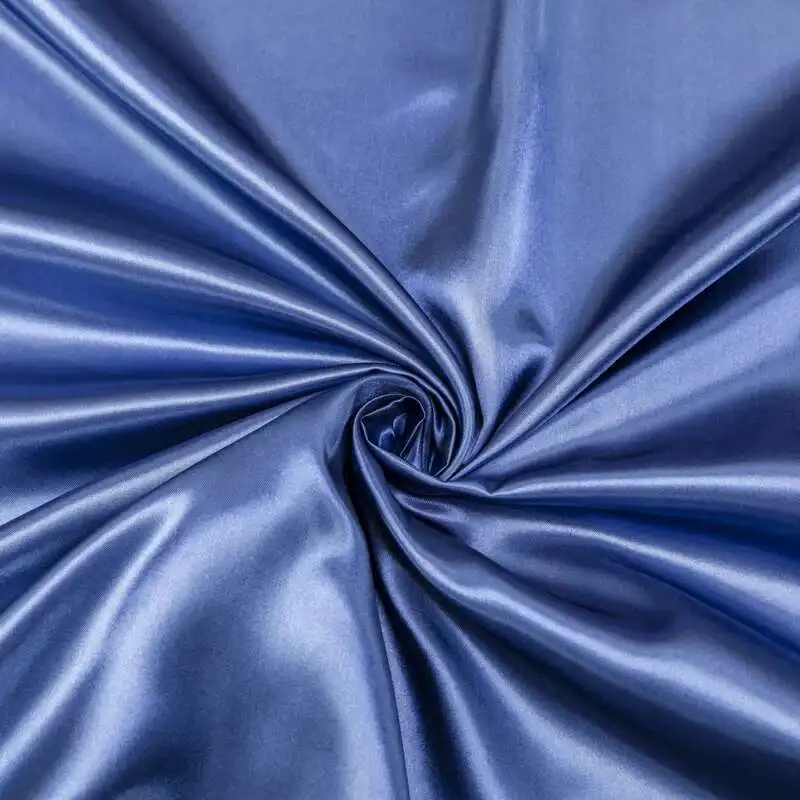
Which Fabric to Choose: Decision Guidelines
With all these factors in mind, here are specific recommendations to help you determine which fabric best suits your particular needs.
For Bedding (Sheets, Pillowcases)
Silk bedding offers superior benefits for:
* Those with sensitive skin conditions like eczema or rosacea
* People concerned about facial wrinkles or sleep lines
* Individuals with frizz-prone, curly, or brittle hair
* Hot sleepers who still want lightweight comfort
* Anyone with allergies to dust mites or other common allergens
* Those who view bedding as a long-term investment in sleep quality
The exceptional benefits of mulberry silk sheets are particularly valuable for these specific concerns, making them worth the additional investment for many users.
Cotton bedding might be preferable for:
* Budget-conscious shoppers seeking good immediate value
* Those who prioritize easy care and machine washability
* People who prefer a crisp, substantial feel to their bedding
* Individuals who change decor frequently and view bedding as temporary
* Those who perspire heavily and need highly absorbent materials
* Families with children where frequent washing is necessary
Many people find success with hybrid approaches, such as using silk sheet and pillowcase sets while keeping cotton duvet covers, or starting with silk pillowcases before investing in complete silk bedding.
Full-size Silk Sheets, King Size Silk Sheets, Queen Size Silk Sheets, Twin Size Silk Sheets, Washable Silk Sheets
Price range: $95.95 through $178.37 Select options This product has multiple variants. The options may be chosen on the product page100% Silk Sheets, Green Silk Sheets, King Size Silk Bedding Set, Mulberry Silk Bedding Sets, Queen Size Silk Bedding Set
Price range: $1,246.21 through $1,615.22 Select options This product has multiple variants. The options may be chosen on the product pageEucalyptus Silk Bedding Sets, Eucalyptus Silk Sheets
Price range: $360.24 through $393.60 Select options This product has multiple variants. The options may be chosen on the product pageGrey Silk Sheets, Silk Sheet and Pillowcase Set
Price range: $88.20 through $146.64 Select options This product has multiple variants. The options may be chosen on the product page- Price range: $267.82 through $306.55 Select options This product has multiple variants. The options may be chosen on the product page
Bamboo Silk Sheets, Cooling Silk Sheets
Price range: $130.76 through $177.80 Select options This product has multiple variants. The options may be chosen on the product page
For Clothing and Apparel
Silk clothing excels for:
* Lightweight, breathable base layers
* Luxurious formal wear and special occasion garments
* Comfortable sleepwear that regulates temperature
* Items where drape and flow are essential to the design
* Garments worn directly against sensitive skin
Cotton clothing is typically better for:
* Everyday casual wear requiring frequent washing
* Athletic wear needing high absorbency
* Structured garments that need to hold their shape
* Children’s clothing requiring durability and easy care
* Warm-weather clothing maximizing breathability
For Specific Needs
For allergies and sensitive skin:
* Silk offers superior natural resistance to allergens and minimal skin friction
* If choosing cotton, select organic varieties and wash frequently in hot water
For hot sleepers and warm climates:
* Both fabrics can work well—silk for its temperature regulation and moisture-wicking
* Lightweight cotton (especially percale) for maximum breathability
For cold sleepers and winter months:
* Silk provides better insulation while maintaining breathability
* Flannel cotton offers cozy warmth but may cause overheating
For budget-conscious shoppers:
* Start with a silk pillowcase to experience benefits at lower cost
* Choose high-quality cotton for items needing frequent replacement
For sustainability focus:
* Look for peace silk or ahimsa silk options that allow moth emergence
* Select organic cotton certified by reputable organizations (GOTS, OEKO-TEX)
Frequently Asked Questions About Silk and Cotton
Is silk stronger than cotton?
Yes, silk is actually stronger than cotton fiber-for-fiber. Silk has remarkable tensile strength despite its delicate appearance. However, in practical use, cotton’s durability often seems greater because it better withstands frequent washing and rough handling.
Which fabric is better for preventing wrinkles while sleeping?
Silk is significantly better at preventing sleep wrinkles. Its smooth surface creates less friction against facial skin, reducing compression and creasing during sleep. Cotton’s more textured surface can create more pronounced sleep lines, especially for side and stomach sleepers.
Can silk be machine washed like cotton?
Some modern silk items can be machine washed on gentle cycles in mesh bags with silk-specific detergents. However, silk requires much more careful washing than cotton, which handles standard machine washing with ease. Always check the care label on silk items before machine washing.
Which fabric is better for people with allergies?
Silk is generally superior for allergy sufferers due to its natural resistance to dust mites, mold, and mildew. Cotton can be hypoallergenic but requires more frequent washing in hot water to remove potential allergens that can accumulate in its more absorbent fibers.
Is cotton or silk better for hot sleepers?
For most hot sleepers, silk provides better overall comfort due to its temperature regulation and moisture-wicking properties. While cotton offers excellent breathability, it can feel damp when saturated with perspiration, potentially causing discomfort for very hot sleepers.
Which fabric is more sustainable?
Both fabrics have sustainability advantages and challenges. Silk uses significantly less water and fewer pesticides than conventional cotton, but raises ethical considerations regarding silkworms. Organic cotton addresses many environmental concerns but still requires substantial water. Overall, both are biodegradable natural fibers, making them more sustainable than synthetic alternatives.
There are many compelling reasons to choose mulberry silk sheets for those with specific concerns about sleep quality, skin health, or allergies. For those ready to experience genuine quality, exploring 100% silk sheets can be a worthwhile investment in better sleep.
Caring for Your Natural Fabrics: Essential Tips
Regardless of which fabric you choose, proper care significantly extends its lifespan and maintains its beneficial properties.
Universal Care Tips for Natural Fabrics
Always start by carefully reading care labels—manufacturers provide specific guidance based on the exact fabric composition and construction. Even within silk and cotton categories, care requirements can vary based on weave, weight, and treatments.
When storing seasonal items like winter comforters or summer sheets, ensure they’re completely clean and dry before placing in storage. Use breathable fabric containers rather than sealed plastic, which can trap moisture and lead to mildew or yellowing.
For stain treatment on either fabric, act quickly but appropriately:
* Blot, don’t rub, to prevent spreading the stain
* Test any stain treatment on an inconspicuous area first
* Use fabric-appropriate stain removers (enzyme-free for silk)
* Rinse thoroughly to remove all cleaning agents
Natural fabrics typically signal when replacement is needed—significant thinning, persistent odors despite cleaning, or visible wear indicate it’s time for new items.
Advanced Care for Premium Fabrics
To extend the life of silk items:
* Rotate bedding to distribute wear more evenly
* Shield from prolonged direct sunlight which can weaken fibers
* Use padded hangers for silk garments to prevent stretching
* Consider occasional professional cleaning for valuable pieces
* Store with acid-free tissue paper to prevent creasing
For maintaining cotton’s quality:
* Wash inside out to reduce surface abrasion
* Use color-safe bleach alternatives for whitening
* Avoid overloading the washer or dryer, which causes excessive friction
* Dry slightly damp if ironing is needed for easier wrinkle removal
* Consider line-drying premium cotton to extend fiber integrity
Adjust care routines seasonally—winter typically requires less frequent washing of bedding due to reduced perspiration, while summer often demands more regular laundering.
Is Blended Fabric the Best of Both Worlds?
For those unable to decide between silk and cotton, blended fabrics offer an intriguing middle ground that combines properties from both materials.
Silk-cotton blends typically contain between 30-70% silk content, with higher silk percentages offering more of silk’s characteristic properties. These blends aim to capture silk’s smooth texture and temperature regulation while incorporating cotton’s durability and easier care requirements.
Common blend ratios include 70/30 silk-cotton (more luxurious feel, some cotton durability) and 50/50 (balanced properties of both fibers). These combinations often perform well in garments like dress shirts, nightwear, and lightweight scarves where both comfort and practicality matter.
Blends typically offer easier care than pure silk—many can be machine washed on gentle cycles—while providing a more luxurious feel than pure cotton. They generally cost less than 100% silk but more than pure cotton, positioning them as middle-market options.
Care requirements for blended fabrics usually follow the needs of the more delicate component (silk in this case), though they’re typically more forgiving than pure silk. While blends don’t perfectly capture all properties of either fabric, they can be ideal for those seeking more practical luxury.
For those who appreciate silk’s benefits but prefer alternatives, vegan silk bedding offers options that mimic many of silk’s properties using plant-based or technologically advanced materials.
Making the Switch: Transitioning Between Fabrics
Changing from one fabric to another often involves an adjustment period as you adapt to different textures, care routines, and performance characteristics.
Transitioning from Cotton to Silk
When moving from cotton to silk bedding, expect an initial adjustment period:
* The slippery texture may feel unfamiliar at first—some sleepers find their pillows slide more easily
* The lightweight nature might initially seem less substantial than cotton
* Care routines will require more attention to detail
* The temperature regulation may feel different, particularly if you’re used to flannel or jersey cotton
Starting with mulberry silk pillowcases offers an excellent entry point—they provide immediate skin and hair benefits with less financial commitment than complete sheet sets. Many people begin with pillowcases, then gradually add other silk bedding pieces as they experience the benefits.
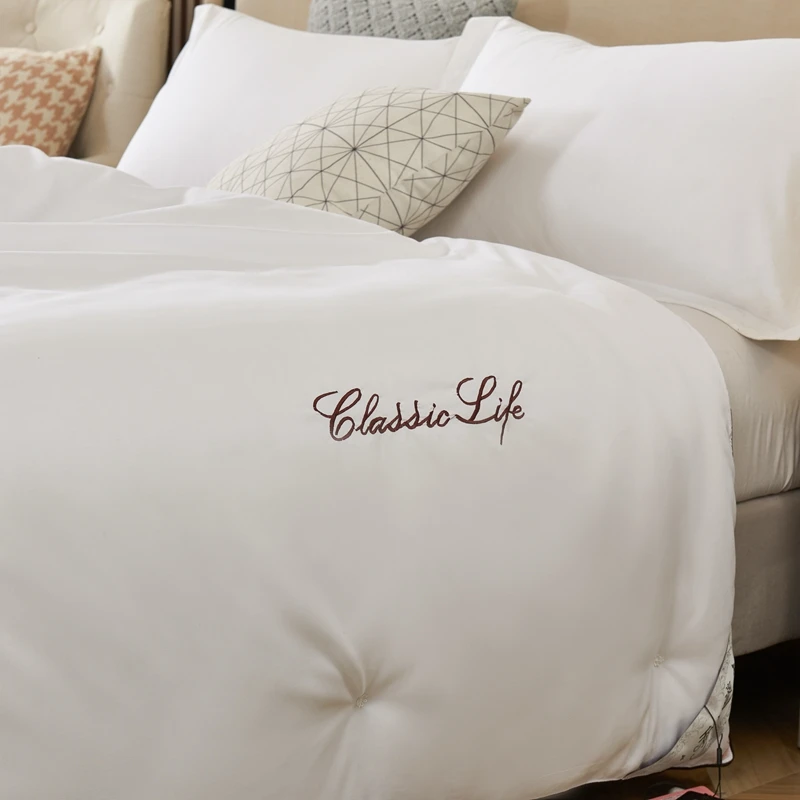
Give yourself at least two weeks to adjust to the new feeling. Many users report that after an initial adjustment period, returning to cotton feels noticeably less comfortable as they’ve grown accustomed to silk’s smooth texture.
Transitioning from Silk to Cotton
Moving from silk to cotton also requires adaptation:
* Expect a more textured feel against skin and hair
* Appreciate the easier care routines and machine washability
* Select high-quality cotton options (Egyptian, Pima) for a more premium experience
* Consider higher thread counts (400-600) for smoother texture
Look for cotton products with special finishes or treatments that enhance softness and reduce friction. Combed cotton and sateen weaves offer smoother surfaces that more closely approximate silk’s feel while maintaining cotton’s practicality.
Many households successfully use both fabrics complementarily—silk for items that directly touch skin (pillowcases, fitted sheets) and cotton for easier-care items like duvet covers and decorative elements. This combination maximizes the benefits of each material while working within practical constraints of care and budget.

